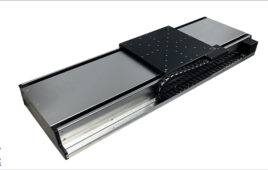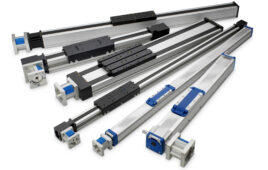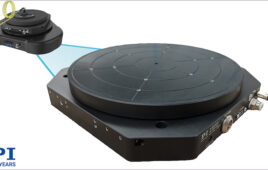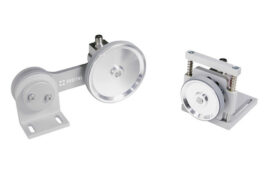Ballscrews are a mainstay in motion applications, partly because their performance is so predictable, and they’re relatively easy to design into machinery. Over the last few years, advances in manufacturing and materials have improved ballscrew performance so OEMs today can get better linear motion with them at lower cost.
For starters, the latest generation of ballscrews have more load density than ever—to give OEMs higher capacity from a smaller package. “Ballscrews deliver high load capacity, high efficiency and reliable operation in a small package; medical and automation are primary drivers for their miniaturization,” said Jeff Johnson, product line specialist at Thomson Industries. Another driver is robotics. “Our ballscrew splines’ compactness have spurred their use in robotics,” said Larry Hansen, corporate director at NB Corp. of America. Case in point: A rotary ball spline his company introduced late last year comes in 6 to 25-mm diameters. “Anybody can make large and medium-large components, but our expertise is in scaling down compact systems and meeting tough quality standards—for artificial limbs or robotic surgical suites, for example,” Hansen said.
Others also reported a trend toward miniaturization, but add that faster ballscrews with rolled and ground screws are another trend. “For example, some ballscrews have caged balls while others with rolled screws have a no-lip return pipe for a tangential pickup. Both features boost speed,” said Yoshiro Oishi, corporate engineering manager at THK America. “Still other ballscrews have newer endplate designs and use newer circulation methods, so their nuts are more compact.” The latter have the same thrust as previous ballscrew designs but are faster for higher machine throughput.
More made in China
There’s been rising ballscrew manufacture in China, but some still question the quality of Chinese ballscrews. “They’ll be a force to reckon with in the future, but the current quality of some Chinese ballscrews means they’re not commonly welcome within Japan, at least,” said Hansen. The equipment that many Chinese manufacturers use to make ballscrews today are of retired vintage, according to Hansen—old machines that other manufacturers purge because the machines no longer hold sufficient accuracies.
A market as large as China is hard to ignore, and if engineers there have nothing to compare, then they may not differentiate levels of ballscrew quality. “But American customers do recognize differences in quality, which is why we sell the same ballscrew spline in Japan that we sell in America,” said Hansen.
Others concede that there are more ballscrew manufacturers in Asia than ever, but stress that a lot goes into ensuring performance: “Ballscrew technology is a mix of advanced material science and mechanical engineering combined with a manufacturing art form that’s hard to duplicate without years of experience,” said Johnson. Even so, Chinese manufacturers affect the market by making ballscrews so cheaply that other countries’ manufacturers aren’t investing capital equipment to make them, according to Hansen … mostly because they can’t make returns on investments. That means when demand is high, there can be ballscrew shortages.
Load capacity and custom life
As mentioned, new ballscrew designs of the last decade get better dynamic load capacity than ever, which is useful in high-load applications or those that need to last. Here, some high-load ballscrews use a proprietary thread to boost load capacity to beyond that of roller screws, said Johnson. He added that many engineers don’t correctly equate the relationship between the dynamic capacity and the life of a ballscrew. The dynamic capacity is the theoretical load to achieve a stated life—a million inches of linear travel, for example—and not the assembly’s operating load limit. Doubling the dynamic capacity has an eight times increase in life. “This is important in applications that run 24/7 and have high revolutions or linear travel requirements,” said Johnson.
For new applications, Hansen cited one ballscrew design that has a single axis capable of positioning, linear and rotary motion. This reduces design bulkiness and weight. Hansen also indicated that unlike other miniaturized ballscrews, NB’s small ballscrew splines are hardened to make them more durable and lasting. Others on the market go into high-volume consumer products where low price is more important than longevity. The result is shorter-lived designs. Hansen gave this example: If your home-office printer breaks after two years and you call the manufacturer, the representative may ask, “Well you’ve had it for some time, so what do you expect?”
In contrast, high-end ballscrews are essential components in the higher-load industrial applications, including robotics. Consider Cartesian robots, assemblies with multiple axes of connected linear-motion components, such as ballscrews and motors, to position loads or tools. “As someone who was once an integrator, I appreciate Cartesian robots,” said Jeff Henshaw, controls engineer at Yamaha Robotics, which distributes in the U.S. through Rankin Corp. “Consider a Cartesian-robot design with ballscrew drives and double bearings on each axis. Such a robot won’t go as fast as the average SCARA, but does reduce the number of points that the controller must command, so can be less expensive.” Plus it has a high payload and excellent repeatability.
From the perspective of some industry professionals, two of the leading industries are machine tool and semiconductor. “They’ve used linear-motion guides for a long time for high accuracy and rigidity … and we continue to do a large amount of business with them,” said Oishi. “We also see growth in the 3D-printer and robotics industries, which need compact linear-motion devices with high rigidity and accuracy.” According to Oishi, applications that are unlike anything that was possible 10 years ago include the use of linear-motion guides and integrated actuators in surgical robots, seismic isolation systems for buildings, humanoid robots and consumer applications—kitchen cabinets and drawers, refrigerators and 3D printers to name a few.
Another trend in ballscrews is that multiple manufacturing processes are giving designers the option to match ballscrew performance to application requirements (and boost the ballscrew assembly’s value). “The combination of nut and screw determines the assembly’s accuracy and repeatability, though there are design and manufacturing challenges on both ends of the size spectrum,” said Johnson. But with multiple ways to manufacture ballscrews and multiple ways to manufacture ball nuts, there’s a tremendous amount of customization possible.
“We also make linear-motion guides that drastically reduce micro-displacements from the balls loading and unloading, a phenomena called waving. These boost precision enough to give end users a cost-effective alternative to hydrostatic bearings,” said Oishi.
Ballscrew actuators
In the past, few offered actuators directly coupled with motors as standard. “But now, we sell rod and slide-type actuators that function as all-in-one options. Both types have electrical sockets to quickly connect to the company’s drives, which in turn run new software that simplifies programing,” added Oishi. That’s because integrated motion actuators have become popular in all kinds of industries, as many end users switch from using components to using integrated actuators as a way to minimize design and manufacturing time. “Engineers who design systems aren’t always linear-motion specialists, so they use integrated stages or actuators to spend more time on function-related design,” said Oishi. “More specifically, the trend in actuator design towards all-in-one packages lets manufacturers spend considerably less time assembling, wiring, and programing the actuator itself, for a decrease in manufacturing lead time.”
Filed Under: Linear Motion Tips




